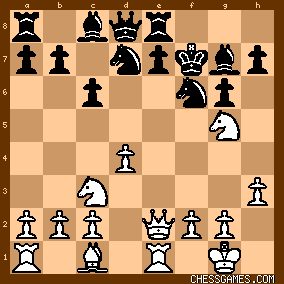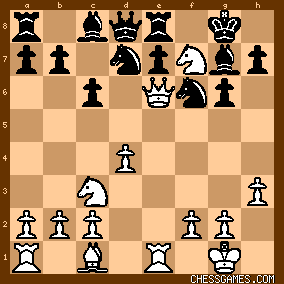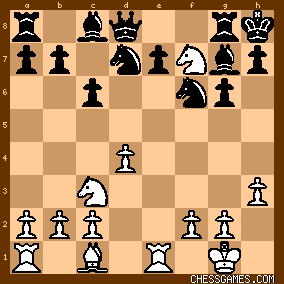|
< Earlier Kibitzing · PAGE 2 OF 2 ·
Later Kibitzing> |
Jul-20-16
 | | Penguincw: Damn it, didn't look close enough at the puzzle. I mean, if 12...Kf8, then queen is lost with 13.Ne6+. If 12...Kg8, then 13.Qe6+ Kh8 14.Nf7+ Kg8 15.Nh6+ Kh8 16.Qg8+ followed by 17.Nf7# 1-0, smothered mate. ...
Oh, and I almost forgot: happy Apollo 11 landing anniversary: Jul/20/1969. |
|
| Jul-20-16 | | goldfarbdj: Be6+ was obvious, and I considered Ng5+. I saw the forced mate after 12. ... Kg8, but after 12. ... Kf8 I considered only 13. Qe6, which allows 13. ... Ne5! staving off mate. (White does come out ahead a pawn after 14. Qxe5.) I missed the queen fork possibility. |
|
| Jul-20-16 | | agb2002: The material is identical.
The light squares around the black king are momentarily weak. This suggests 11.Bxf7+: A) 11... Kxf7 12.Ng5+
A.1) 12... Kf8 13.Ne6+ (13.Qe6 Ne5) and 14.Nxd8 + - [Q+P vs B+N]. A.2) 12... Kg8 13.Qe6+ and mate in four at most.
B) 11... Kf8 12.Bxe8 + - [R+P vs B].
C) 11... Kh8 12.Bxe8 + - [R+P vs B]. |
|
| Jul-20-16 | | drollere: curse that f7 square! i had
11. Bxf7+ Kxf7
12. Qe6+ Kf8
13. Nf5 (any)
14. Qf7#
the game line is imprecise; because the N checks before the Q, the K can end up on h8. and although Nf7+ then wins the black Q (with discovered check), it's more work. nadal gave up before he was beaten; black could decline the sacrifice: 11. Bxf7+ Kh8
12. Bxe8 Qxe8
13. Qxe7 Qxe7
14. Rxe7
and white is up the exchange and two pawns, but gets a few free moves kicking the rook around. so there's that. |
|
| Jul-20-16 | | YouRang: This was fun! 11.?

click for larger view
As happens often, the Pf7 square is the target:
- It is hit by our LSB
- our Nf3 and Q are both one move away from hitting it. - the removal of Pf7 makes e6 accessible to both Qe6 and Ng5-e6. - if the black king captures on f7, our N can hop to g5 with check. All of this suggests the correct move order: (1) kill Pf7 with check using the LSB <11.Bxf7+!>, which by itself wins a P and the exchange and removes the guard of e6. If black recaptures via <11...Kxf7>, we advance the N with check <12.Ng5+>.

click for larger view
Black has two choices, but let's eliminate 12...Kf8 13.Ne6+, which forks the queen. That leaves <12...Kg8> which is more fun: <13.Qe6+ Kh8> ...Kf8? Qf7# <14.Nf7+ Kg8>

click for larger view
This should be a familiar pattern for puzzle solvers, as it leads to the smother-mate: <15.Nh6++ Kh8 16.Qg8+! Rxg8 (or ...Nxg8) 17.Nf7#>

click for larger view |
|
| Jul-20-16 | | Cheapo by the Dozen: The reason this is a Wednesday problem and not easier yet is that the most natural line actually fails: 11 Bxf7+ Kxf7
12 Qe6+ Kf8
13 Ng5
loses to 13 ... Ne5.
Ditto if White transposes Moves 12 and 13.
However, the transposed order wins in another way:
11 Bxf7+ Kxf7
12 Ng5+ Kf8
13 Ne6+
is a winning fork.
Meanwhile,
12 ... Kg8
13 Qe6+ Kh8
14 Nf7+
leads to the classic smothered mate, while just declining the sacrifice on Move 11 entails unacceptable loss of material. |
|
| Jul-20-16 | | cocker: <Cheapo by the Dozen> I don't think your first line 'loses'. After 13 ...Ne5, White can win with 14 dxe5; even 14 Qxe5 keeps a small edge. |
|
| Jul-20-16 | | saturn2: 13 Qe6+ Ne5 14 QxNe5 I was content with winning a pawn (and exchanging B for N) |
|
| Jul-20-16 | | dfcx: The f7 square is weak.
11.Bxf7+ wins
A. 11...Kf8/Kh8 12.Bxe8 
B. 11...Kxf7 12.Ng5+
B1. 12...Kg8 12.Qe6+ Kh8 13.Nf7+ Kg8 14.Nh6+ Kh8 15.Qg8+ Rxg8 16.Nf7# B2. 12...Kf8 12.Ne6+ Kg8 13.Nxd8  |
|
| Jul-20-16 | | thegoodanarchist: Of course I spotted 11.Bxf7+ right away, but assumed after 11...Kxf7 that 12.Qe6+ was next. But not so fast, because 12...Kf8 means that 13.Ng5 is without check, so Black can play 13...Ne5, which covers the mating square f7 and unleashes a discovered attack on the White queen simultaneously. |
|
| Jul-20-16 | | Oxspawn: <Penguincw> <Apollo 11 landing anniversary: Jul/20/1969>
If you look carefully at the shadows on the board, and the way the king's cross flutters as you play the move, you will see that the knight could not have possibly moved to g5. This 'move' must have been projected onto the board from Nevada. |
|
| Jul-20-16 | | Virgil A: Smothered. |
|
| Jul-20-16 | | BOSTER: This is not a shame to be caught into the same trick like Reshevsky. |
|
| Jul-20-16 | | YetAnotherAmateur: <thegoodanarchist>
In your line, after 11.Bxf7+ Kxf7 12. Qe6+ Kf8 13. Ng5 (threatening Qf7#) Ne5 14. Qxe5 at least nets white the pawn.But the game line, 11. Bxf7+ Kxf7 12. Ng5+ is better, because 12. ... Kf8 can be met by 13. Ne6+. Or 12. ... Kg8 13. Qe6+ Kh8 (or 14. Qf7#) 14. Nf7+, winning the queen and the game. |
|
| Jul-20-16 | | The HeavenSmile: <YetAnotherAmateur> not just the pawn, after 13...Ne5, 14.dxe5! and then 14...Bxe6 15. Nxe6+ Kf7 16. Nxd8+ Raxd8 17. exf6 Bxf6 and white emerges a piece up. But the game line is still better |
|
| Jul-20-16 | | YetAnotherAmateur: <The HeavenSmile> Quite right! This is why I'm an amateur, missing simple combinations like that. |
|
| Jul-20-16 | | kevin86: The text leads to quick mate or the loss of the queen. 12 ♕e6+ also wins, but is not the best move. |
|
| Jul-20-16 | | Chess Dad: <YetAnotherAmateur: 14. Nf7+, winning the queen and the game.> After 14.Nf7+ Kg8, yes, the queen can be taken, and you'll probably win the game. But smothered mate is quicker, and is only mate in three. 15. Nh6++ Kh8 [Kf8 16. Qf7#] 16. Qg8+ Rxg8 17. Nf7#.
I missed it also. I saw the first two moves, and saw that they would be reasonably strong and forcing moves, but couldn't see the smothered mate after 13. Qg5+. I clicked through the game summary and wondered why Black resigned at first until I saw the comments. |
|
Jul-20-16
 | | gawain: Good puzzle. It is hard to believe, at first glance, that Black's position is so vulnerable. But that f7 square ...
and then that e6 square, too... |
|
| Jul-20-16 | | YouRang: Funny, I never even considered 12.Qe6+.
Good thing, since 12.Ng5+ is better. Next move it will either fork K+Q or assists Qe6+ in mate. |
|
Jul-20-16
 | | ajk68: <Yep, he proved that grandmasters have amateurs for breakfast.> Especially with an unsound opening. It's not at all clear what black's plan was by playing c6 (looks like a novelty), 0-0, Nbd7. It seems haphazard and aimless. c6 could be a prelude to a queen-side space gain, but there doesn't seem to be any movement in that direction. As it is, it deprives the knight of the c6 square. When he moves the knight to d7, he hems in his bishop. Black needed a plan to activate his bishop. Possibly b5 followed by Nb6, or a5 and Nb6, would make space for development of the bishop to b7 or d7. d7 is probably not going to be as active; black as to figure out how to protect the e7 pawn. Pushing to e6 would seal in a bishop on d7. |
|
| Jul-20-16 | | Stalwart: Nice little double whammy
bterranlong.wix.com/whitemates |
|
Jul-20-16
 | | PawnSac: well, looks pretty simple..
white gains the exchange and pawn with 11.Bxf7 Kh8 12.Bxe8 Qxe8 black has some weak squares but I'd play on a bit and make white prove something significant. |
|
| Jul-20-16 | | Herma48852: The space advantage by White is so overwhelming there had to be a material winning combination in there .. and this time I found it:
11. Bxf7 Kxf7
12. Ng5+ Kg8
13. Qe6+ Kg8
14. Nf7+ and smothered mate to follow. |
|
Jul-21-16
 | | perfidious: <pawnhack....black has some weak squares but I'd play on a bit and make white prove something significant.> In order to do so in any meaningful fashion, you would first need to be able to evaluate what 'something significant' is, which you are not yet capable of--maybe next life. |
|
 |
|
< Earlier Kibitzing · PAGE 2 OF 2 ·
Later Kibitzing> |





